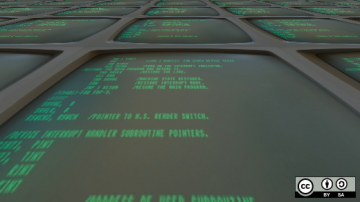What's my terminal of choice?
I use xterm. That's right, xterm. It may seem like an old school choice, and I do use GNOME 3 now as well, but after many years of trying some and ignoring others, then going back to old standbys, I find I don't need (or like) newer stuff like GNOME Terminal.
My philosophy: Start simple, improve over time, and aim for productivity.
Background and foreground
I start up xterm with this script:
#!/bin/bash
bg=rgbi:`dd if=/dev/urandom bs=1 count=3 2>/dev/null | od -tu1 | awk
'{b=0.1/256; printf("%s/%s/%s\n", $2*b, $3*b, $4*b); exit(0)}'`
exec xterm -bg $bg -fg white "$@"
The -bg option sets a relatively dark random background, while -fg sets the foreground (the text) to white.
I like to set my monitor to be rather dark (contrast 70, brightness 10) because pure white on black is a bit too dark for me, while a lighter background is a bit too much light.
Clicks
One thing I like about xterm is how selection works. A double-click of the left mouse button (LMB) selects a word, a triple-click selects "longer words" (see the configuration), four clicks selects lines, a middle-click pastes (or shift-insert), and finally, a right-click extends.
When extending, it continues to obey the "rules" for existing selections. If you double-click, the left button extends the selection to the whole word it contains. This is the relevant part of $HOME/.Xresources:
XTerm*on2Clicks: word
XTerm*on3Clicks: regex [^ \n]+
XTerm*on4Clicks: line
The concept of a "word" (for a double-click selection) is a narrow definition. When double-clicking on part of a file path, only that part is selected. A triple-click selects the full path.
Alternate screen
I like to disable the alternate screen. Why is that, you ask?
Suppose that you open a terminal, and you want to run some command, but then decide you have to look something up in its manpage first. So you run man somecommand, find what you want, exit less with q, and suddenly the man text is gone!
If you had intended to copy and paste from it, you have to start it again, or else open it in a separate terminal window.
I can see why this function was added in the past—to return you to your previous context—but I don't like this behavior.
So, I disable it with this code in .Xresources:
XTerm*titeInhibit: true
Fonts
I use xterm with a custom bitmapped font that I created by adapting the standard 10x20 Unicode one and editing the Hebrew letters to suit my taste. I guess it's about time I looked for a more modern scalable font; I'll probably have no choice soon, what with HiDPI monitors and Wayland becoming prevalent, but my custom font works well for now.
Colors for Vim
With the white text on a dark background, colors are usually too dark for me, especially with Vim's default syntax highlighting. I prefer to set them to something a little lighter:
! red, green, yellow, blue, magenta, cyan
XTerm*VT100*Color1: #ff8080
XTerm*VT100*Color2: #b0ffb0
XTerm*VT100*Color3: #ffffb0
XTerm*VT100*Color4: #b0b0ff
XTerm*VT100*Color5: #ffb0ff
XTerm*VT100*Color6: #b0ffff
! bright: red, green, yellow, blue, magenta, cyan
XTerm*VT100*Color9: #ffd0d0
XTerm*VT100*Color10: #d0ffd0
XTerm*VT100*Color11: #ffffd0
XTerm*VT100*Color12: #d0d0ff
XTerm*VT100*Color13: #ffd0ff
XTerm*VT100*Color14: #d0ffff
X selection and clipboard
I want selections to be present in both the X selection and in the clipboard, so I don't have to think about what the target application (where I want to paste) wants to use, or how it wants to use it.
XTerm*VT100*selectToClipboard: true
Login action
In the rather distant past, the login process on X automatically loaded the resources for you from $HOME/.Xresources. I'm not sure what's left of this practice by default, but it didn't work for me on RHEL8 with GNOME 3. Here's how I fixed that.
First, I placed this script in $HOME/bin/xrdb-merge-resources:
#!/bin/sh
xrdb -merge $HOME/.XresourcesThen I created the file $HOME/.config/autostart/xrdb-merge-resources.desktop:
[Desktop Entry]
Name=xrdb-merge-resources
Exec=/home/ybardavi/bin/xrdb-merge-resources
Type=Application
Finally, I set it to autoload by adding it to GNOME's startup applications.
xterm
Xterm is more customizable than you might expect, which is one of its many benefits. Get comfortable with it, and it'll reward you for your effort.









1 Comment